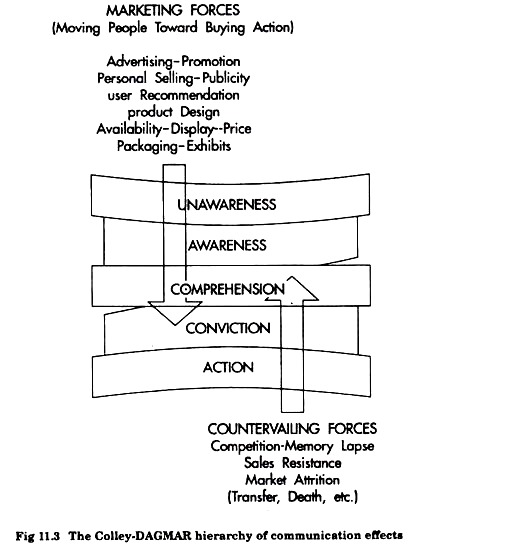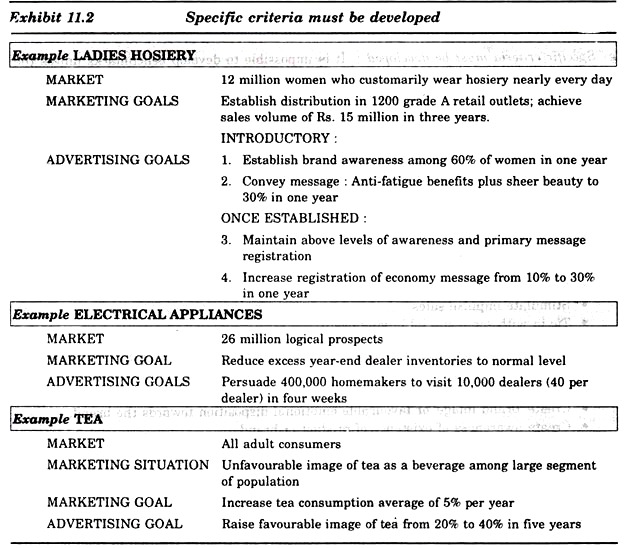DAGMAR was the study of Association of National Advertisers (ANA) that the goal of advertising is to achieve specialized objectives and it recognized that different advertisements can have a number of objectives.
“Advertising’s job, purely and. simply, is to communicate to a defined audience information and a frame of mind that stimulates action. Advertising succeeds or fails, depending on how well it communicates the desired information and attitudes to the right people at the right time and at the right cost.” Russel H. Colley.
The concept known as DAGMAR—Defining Advertising Goals For Measured Advertising Results.
Colley defined an advertising objective as a “specific communication task, to be accomplished among a defined audience to a given degree in a given period of time”.
DAGMAR Approach can be summarized in the following seven points:
(a) Advertising goals are virtually always communication goals:
Colley pointed out that advertising is only one part of the marketing mix for all companies. He assumed that specific goal for advertising in virtually all situations would have to be represented in terms of some communication objective.
(b) Goals should be written down:
The goals should be made very clear in form of writing, so that everyone understands what is being done.
(c) Advertising should be measured in terms of effects, not exposures:
Colley pointed out that in reaching out a certain number of potential consumers, no matter how astronomical that number seems to be, is meaningless unless there is some effect in terms of communication goals.
(d) Advertising operates through a hierarchy of communication effects:
Colley was very specific as to the levels of this hierarchy and their relationship over time in response to advertising effort. His model suggests that there is a series of mental step through which a brand or objects must climb to gain acceptance. (Fig. 11.3) An individual start at some point by being of the brand’s presence in the market. The initial task of the brand is to gain awareness to advance one step up in the hierarchy.
The next step brand comprehension involves the audience member learning something about the brand. What are its specific characteristics and appeals including associated imaginary and feelings? In what way it differs from its competitors? Whom is it supposed to benefit?
The next step is the attitude and conviction step and intervenes between comprehension and final action. The action phase involves some overt move on the part of the buyer like trying the brand for the first time, visiting a show room or requesting information. (Exhibit 11.1)
(e) Creative planning considerations should come before media decisions in the advertising planning process:
When media considerations come first, there is a tendency to be concerned about the amount of reach an advertising campaign can develop rather than the effects that are to be generated. The creative or message strategy decision is always intimately related to the communication effects that are intended. Therefore, the creative planning decision should occur first.
(f) Benchmark measurements should be developed before the campaign is implemented:
Colley suggested a particular research procedure for measuring advertising effectiveness. This involved developing a measurement of the level of an objective before the campaign and then measuring deviations from the measurement as an indicator of communication effect.
(g) Specific criteria must be developed:
It is impossible to develop benchmarks unless the objectives are stated specifically in terms of some operational measurement. This means that the advertising objective should state the specific target market segment, the marketing goal in some percentage terms over sometime period and the advertising goals, again in terms of a percentage attainment in a particular time period. (Exhibit 11.2)
Colley identified 52 advertising tasks or advertising objectives that a firm can pursue. He still said that this list is still incomplete.
These advertising objectives are:
1. Perform the complete selling function (take the product through all the necessary steps toward a sale).
2. Close sales to prospects already partly sold through past advertising effects (“ask for the order” or “clincher” advertising).
3. Announce a special reason for “buying now” (price, premium, etc.).
4. Remind people to buy.
5. Stimulate impulse sales.
6. Tie in with some special buying event.
Does the advertising aim at near term sales by moving the prospect step by step, close to a sale (so that when confronted with a buying situation the customer will ask for, reach for or accept the advertised brand)?
1. Create ‘brand image’ or favourable emotional disposition towards the brand.
2. Create awareness of existence of product or brand.
3. Combat or offset competitive claims.
4. Implant information or attitude regarding benefits and superior features of brand.
5. Build familiarity and easy recognition of package or trademark.
6. Correct false impressions, misinformation and other obstacles to sales.
Does the advertising aim at building a ‘long range’ customer franchise?
1. Build customer demand which places company in stronger position in relation to its distribution (not at the “mercy of the market place”)
2. Build confidence in company and brand which is expected to pay off in years to come.
3. Secure universal distribution.
4. Place advertiser in position to select preferred distributors and dealers.
5. Establish brand recognition and acceptance which will enable the company to open up new markets (geographic, price, age, sex).
6. Establish a “reputation platform” for launching new brands or product lines.
7. Specifically, how can advertising contribute toward increased sales?
8. Hold present customers against the in roads of competition.
9. Cause people to specify advertiser’s brand instead of asking for product by generic name.
10. Convert competitive users to advertiser’s brand.
11. Make steady customers out of occasional or sporadic customers.
12. Convert non users of the product type to users of product and brand.
Increase consumption among present users by:
a. Persuading customers to buy larger sizes or multiple units.
b. Advertising new uses of the product.
c. Encouraging greater frequency or quantity of use.
d. Reminding users to buy.
Does the advertising aim at some specific step which leads to a sale?
a. Persuade prospect to visit a show room, ask for a demonstration.
b. Induce prospect to sample the product (trial offer).
c. Persuade prospect to write for descriptive literature, return a coupon, enter a contest.
d. Aid salesman in getting preferred display space.
e. Aid salesmen in opening new accounts.
f. Aid salesmen in getting larger orders from’ whole sellers and retailers.
g. Build morale of company sales force.
h. Impress the trade causing recommendation to their customers and favourable treatment to salesmen.
i. Give salesmen an entry.
Is it a task of advertising to impart information needed to consummate sales and build customer satisfaction?
a. “How to use it” advertising.
b. New prices.
c. “Where to buy it” advertising.
d. New models, features, package.
e. New policies (guarantees, etc.).
f. Special terms, trade in offers, etc.
g. To what extent does the advertising aim at building confidence and good will for the corporation among.
h. The trade (distributors, dealers, retail sales people).
i. Customers and potential customers.
j. The financial community.
k. Employees and potential employees.
l. The public at large.
m. Service.
n. Product quality, dependability.
o. Corporate citizenship.
p. Growth, progressiveness, technical leadership.
Benefits of Specific Advertising Goals:
Colley suggested the following benefits of the DAGMAR Process:
1. As the work of creating advertising is done by more specialists with narrow views beyond their own tasks, it becomes necessary for all involved to be able to see the common goal. The statement of objectives reduces wasted effort and keeps the advertising team on target by clearly showing what needs to be said.
2. People do better work when they have a clear toward what they are aiming. Specific goals allow all who are involved with the process to deal with the appropriate issues.
3. Being specific allows measurement, which allows a better allocation of budgeted resources. The budget is aided in the short run of the current campaign and is also helped in the long run. By measuring success and failure, the firm gains insight for appropriate budgets in future campaigns.
4. Goals are critical because advertising is intangible and the resulting process is amorphous. Because advertising is so subjective, any opportunity to introduce objectivity must be used.
Dagmar: Attacks & Counters:
DAGMAR had enormous visibility and influence. Seven points given by colley was accepted enthusiastically by a wide variety of scholars of advertising process and by advertising agency people as well as several large advertisers such as General Motors.
The DAGMAR is criticized on the following points:
1. Some people believe that any of the marketing communication elements should be measured in terms of its sales effectiveness rather than some intermediate goal.
2. The objection focuses on many implementation difficulties inherent in the DAGMAR approach. In particular, the checklist falls short of providing sufficient details to implement the approach.
3. Substantial conceptual and measurement problem underlie the DAGMAR approach.
4. According to critics, the only relevant measure of advertising objectives is sales. But there are so many advertisements which are unable to increase sales but are able to achieve communication objectives. Advertising is seen as effective only if it induces consumers to make a purchase.
5. The attack is that DAGMAR is applicable only to large organisations. It lacks practicability for small organisations. Colley insistence on setting specific goals, writing them down and researching with benchmarks and specific measure criteria all suggest a very expensive and rigid managerial and research programme. The research that colley suggested is quite expensive.
Multiple Communication Objectives:
Objectives are multiple in nature. As there is hierarchy of positions in the same way the objectives also have hierarchy. One set of objective is insufficient. Different objectives may be needed at different points of time of the year. This is most likely to occur in the fast changing world of a new product introduction or for products with severe seasonality.
For example, for a new convenience good introduction, the goal for the first three months may be to generate awareness, the goal of the next three months may be to generate trial, and the goal for the final six months of the first year may be to ensure repeat purchases and the development of loyalty.
Because most advertising plans cover a one year period, it will be necessary to set goals to cover that entire year. It is easy to see that this may mean multiple objectives.
With the goals of the previous paragraph established for the first year, there might be a very heavy advertising campaign during the first quarter. In the second quarter, the strategy might show lighter advertising but heavy promotion geared to trial usage (such as samples and print or mail delivered coupons).
The third and fourth quarters would probably show promotions geared to repeat usage such as in pack coupons and multiple purchase refund offers. In this way the strategies would be consistent with the objectives and the introduction would proceed smoothly while moving consumers through the hierarchy from unawareness to awareness to trial to repeat usage.


